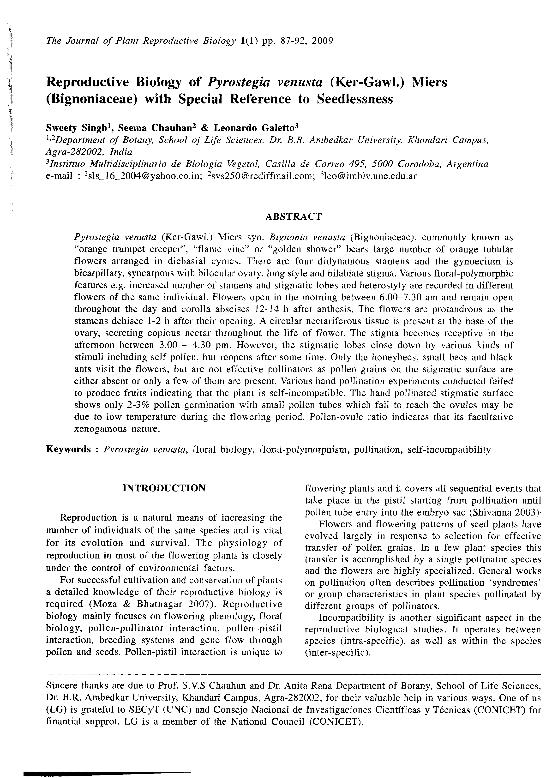Artículo
Reproductive biology of Pyrostegia venusta (Ker-Gawl.) Miers (Bignoniaceae) with special reference to seedlessness
Fecha de publicación:
01/2009
Editorial:
The Society of Plant Reproductive Biology
Revista:
The Journal of Plant Reproductive Biology
ISSN:
0975-4296
e-ISSN:
2249-7390
Idioma:
Inglés
Tipo de recurso:
Artículo publicado
Clasificación temática:
Resumen
Pyrostegia venusta (Ker-Gawl.) Miers syn. Bignonia venusta (Bignoniaceae), commonly known as “orange trumpet creeper”, “flame vine” or “golden shower” bears large number of orange tubular flowers arranged in dichasial cyme. There are four didynamous stamens and the gynoecium is bicarpillary, syncarpous with bilocular ovary, long style and bilabiate stigma. Various floral-polymorphic features e.g. increased number of stamens and stigmatic lobes and heterostyly are recorded. Flowers open in the morning between 6.00–7.30 and remain open throughout the day and corolla abscises 12-14 h after anthesis. The flowers are protandrous as the stamens dehisce 1-2 h after their opening. A circular nectariferous tissue is present at the base of the ovary, secreting copious nectar throughout the life of flower. The stigma becomes receptive in the afternoon between 3.00 – 4.30 pm. However, the stigmatic lobes close down by various kinds of stimuli including self pollen, but reopens after some time. Only the honeybees, small bees and black ants visit the flowers, but are not effective pollinators as pollen grains on the stigmatic surface are either absent or only a few of them are present. Various hand pollination experiments conducted failed to produce fruits indicating that the plant is self-incompatible. The hand pollinated stigmatic surface shows only 2-3% pollen germination with small pollen tubes which fail to reach the ovules may be due to low temperature during the flowering period. Pollen-ovule ratio indicates that its facultative xenogamous nature.
Palabras clave:
Biologia Reproductiva
Archivos asociados
Licencia
Identificadores
Colecciones
Articulos(IMBIV)
Articulos de INST.MULTIDISCIPL.DE BIOLOGIA VEGETAL (P)
Articulos de INST.MULTIDISCIPL.DE BIOLOGIA VEGETAL (P)
Citación
Singh, Sweety; Chauhan, Seema; Galetto, Leonardo; Reproductive biology of Pyrostegia venusta (Ker-Gawl.) Miers (Bignoniaceae) with special reference to seedlessness; The Society of Plant Reproductive Biology; The Journal of Plant Reproductive Biology; 1; 1; 1-2009; 87-92
Compartir




